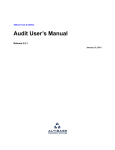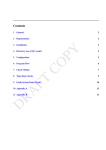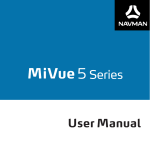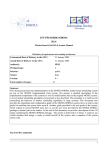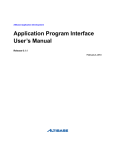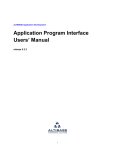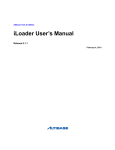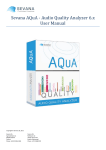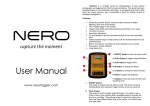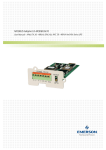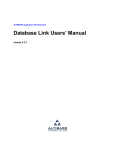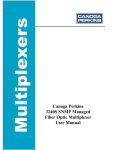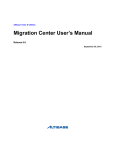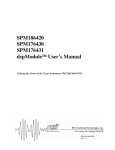Download Audit Users` Manual - ALTIBASE Customer Support
Transcript
ALTIBASE Tools Audit Users’ Manual release 5.3.3 1 Contents Preface ............................................................................................................................................................................. i About This Manual ...................................................................................................................................................................................ii Target Users.................................................................................................................................................................................ii Software Environment.............................................................................................................................................................ii Organization ...............................................................................................................................................................................ii Documentation Rule ................................................................................................................................................................ii References...................................................................................................................................................................................iv Online Manual ...........................................................................................................................................................................iv Altibase Welcomes Your Opinions!....................................................................................................................................iv 1. Overview ....................................................................................................................................................................1 Introduction................................................................................................................................................................................................2 Terminology of the Replication............................................................................................................................................2 Inconsistency Record ...............................................................................................................................................................2 Synchronization Policy ...........................................................................................................................................................3 Running Audit Utility...............................................................................................................................................................................5 2. Controlling Data Inconsistency................................................................................................................................7 Configuring Audit Utility........................................................................................................................................................................8 Audit Property File ....................................................................................................................................................................8 Execution Options.....................................................................................................................................................................9 Table Group.............................................................................................................................................................................. 10 Extracting DIFF Records Logs............................................................................................................................................................ 13 Setting DIFF Option............................................................................................................................................................... 13 Execution Commands........................................................................................................................................................... 13 Execution Results ................................................................................................................................................................... 13 Syncronizing Automatically............................................................................................................................................................... 15 Setting SYNC Option ............................................................................................................................................................. 15 Execution Command ............................................................................................................................................................ 15 Execution Results ................................................................................................................................................................... 15 3. Examples ..................................................................................................................................................................17 Example of DIFF Records Logs.......................................................................................................................................................... 18 DIFF Example 1........................................................................................................................................................................ 18 DIFF Example 2........................................................................................................................................................................ 18 DIFF Example 3........................................................................................................................................................................ 19 Example of Synchronization.............................................................................................................................................................. 20 SYNC Example 1...................................................................................................................................................................... 20 SYNC Example2....................................................................................................................................................................... 20 SYNC Example 3...................................................................................................................................................................... 21 Example ..................................................................................................................................................................................... 21 Preface i Preface About This Manual About This Manual This manual describes how to monitor and administrator Altibase replication using Audit utility. Target Users This manual could be useful for the following Altibase users. • Database administrators • Application designers • Programmers Before reading this manual, understanding of following background knowledge is recommended. • Basic knowledge required for computers, operating systems, and operating system command • Experience in using the relational database or understanding of the database concepts • Computer programming experience Software Environment This manual has been prepared assuming Altibase 5.3.1 will be used as the database server. Organization This manual has been organized as follows: Chapter 1. Overview This chapter discribes what is the Autit and Inconsistency controlling methods for Altibase Replication Servers. Chapter 2. Controlling Data Inconsistency This chapter describes the auditing environment file that explains information necessary for auditing, and then describes DIFF and SYNC features. Chapter 3. Example This chapter describes examples of using comparison (DIFF) and synchronization (SYNC) features. Documentation Rule This chapter describes the rules of this manual. With understanding of this rule, it is easy to search information in this manual and other manuals. Audit Users’ Manual ii About This Manual Rules are as follows: • Syntax diagram • Sample code rule Syntax Diagram This manual describes the command syntax using the diagram composed of the following elements: Elements Meaning The command starts. The syntax element which is not a complete command starts with an arrow. Reserved word The command continues to the next line. The syntax element which is not a complete command terminates with this symbol. The command continues from the previous line. The syntax element which is a complete command starts with this symbol. End of a statement. ; Mandatory SELECT Optional NOT Mandatory field with optional items. Only one field must be provided. ADD DROP iii Preface About This Manual Elements Meaning Optional field with optional item. ASC DESC Optional multiple fields are allowed. The comma must be in front of every repetition. ASC DESC , References For more detailed information, see the following document. • Altibase Administrator’s Manual • Altibase Replication User’s Manual • Altibase iSQL User’s Manual • Altibase Utilities User’s Manual • Altibase Error Message Reference Online Manual Korean and English versions of on-line manuals (PDF or HTML) are available from Altibase Download Center (http://atc.altibase.com/). Altibase Welcomes Your Opinions! Please send us your comments and suggestions regarding this manual. Your comments and suggestions are important, and they may be used to improve future versions of the manual. When you send your feedback, please make sure to include the following information: • The name and version of the manual in use • Your comments or suggestions regarding the manual • Your name, address, and phone number Audit Users’ Manual iv About This Manual Please send your e-mail to the following address: [email protected] This address is intended to report any errors or omissions discovered in the manual. When you need an immediate assistance regarding technical issues, please contact Altibase Customer Support Center. We always appreciate your comments and suggestions. v Preface About This Manual Audit Users’ Manual vi 1 Overview This Chapter discribes what is the Autit and Inconsistency controlling methods for Altibase Replication Servers. 1 Overview Introduction 1.1 Introduction It compares the database of the Altibase server being replicated with the database of the Altibase server to be replicated or with the database of the Oracle server to be replicated by table. If there is any inconsistency, it displays inconsistent information and corrects the inconsistency. 1.1.1 Terminology of the Replication Local Server The server to execute auditing. Remote Server The remote server subject to replication. Master Server There are the local or remote server as standard server for auditing. Master DB The database of the master server. Slave Server There are the local or remote server as standard server for auditing. Slave DB The database of the slave server. 1.1.2 Inconsistency Record Inconsistency is checked by comparing records of the table in the mster DB with the one in the slave DB using primary key. There are three types of inconsistency: • MOSX Unsynchronization : When a record in the master DB but is not in the slave DB • MOSO Unsynchronization : When both master and slave table has the same value for primary key columns but the value in the non-primary key column is defferent • MXSO Unsynchronization : When a record is not in the master DB but is in the slave DB Audit Users’ Manual 2 Introduction 1.1.3 Synchronization Policy A policy that specifies how to synchronize inconsistent records The auditing program fixes the master DB as the reference DB and synchronizes it with the slave DB. There are four synchronization policies: • SU Policy : It is the policy to resolve the MOSO inconsistency by updating the slave DB to the contents of the master DB. • SI Policy : It is the policy to resolve the MOSX inconsistency by inserting the record of the master DB into the slave DB. • MI Policy : It is the policy to resolve the MXSO inconsistency by inserting the records of the slave DB into the master DB. 3 Overview Introduction • SD Policy : It is the policy to resolve the MXSO inconsistency by deleting the records from the slave DB. The user can define SU policy, SI policy, MI policy, and SD policy in the auditing environment file. Note that MI policy and SD policy are exclusive and they cannot be defined at the same time. Extracting Different Records Log Method DIFF Create a execution result file by identifying the inconsistent records that may occur during replication between the master DB and the slave DB. Automatic Synchronization Method SYNC Identify the inconsistent records between the master DB and the slave DB, resolve the inconsistency according to the synchronization policy in the audit environment file, and create an execution result file including execution summary data and the error data. Audit Property File An environment file to set the option to execute auditing. This file includes connection information, auditing feature, and synchronization policy. Audit Users’ Manual 4 Running Audit Utility 1.2 Running Audit Utility To use auditing feature, the user must create an auditing environment file that includes information about the table where DIFF or SYNC feature is performed. Audit environment file will be explained at Audit Environment File Section of Operation Method. Auditing commands are as follows: shell> audit -f script_file_name script_file_name : File name including the path of the environment file or If current directory is as follows: /user/charlie/altibase_home/audit /user/charlie/altibase_home/audit> audit script_file_name (/user/charlie/altibase_home/audit> audit ./script_file_name) The separate feature for auditing between Altibase server and Oracle server can be included in the package. 5 Overview Running Audit Utility Audit Users’ Manual 6 2 Controlling Data Inconsistency This chapter describes the auditing environment file that explains information necessary for auditing, and then describes DIFF and SYNC features. 7 Controlling Data Inconsistency Configuring Audit Utility 2.1 Configuring Audit Utility The environment file describes the comparison and synchronization operations, and each includes unique properties: The property contains information necessary for running the program. (See sample.cfg under audit directory.) 2.1.1 Audit Property File The property format is "property name = property value" and is case insensitive. The environment file can include symbols that have special meaning: • "#" represents comments and ignores the character strings after the symbol. • "{ }" symbol is to describe the property value in multiple lines. • " ; " mark as an identifier to separate multiple values. • ‘ “ ‘ mark is used on character string when including reserved or special character on user name, password, table name, column name. Altibase porvides special characters- ‘~, !, @, #, $, %, ^, &, *, (, ), _, +, |’ Property Name It consists of characters without blank and identifies the property in the group. Property Value It can have a single value, multi values, or expressions. • The expression may include blank, and most properties have this format. E.g. 1) TABLE = EMPLOYEE • The multiple value has several single values separated by ";" identifier, and the property value in multiple line must be within "{}{ }". (Example 2) "Exclude" group allows multiple values. E.g. 2) EXCLUDE = ENO; DNO; ENAME Or EXCLUDE = {ENO; DNO; ENAME} • The expression is to express character strings including blank and must be within "{}{ }". "Where" property has expression. E.g. 3) WHERE = { ENO > ‘1000’ and ENO < ‘2000’ } Data Type Support ALTIBASE doesn't support CLOB and BLOB if database is Oracle. You should use EXCLUDE property as follows to exclude certain column for Audit. Example 4) You should exclude certain column for AUDIT when CLOB column exists on EMP table. Audit Users’ Manual 8 Configuring Audit Utility TABLE = EMP EXCLUDE = { CCC } 2.1.2 Execution Options Specifies the synchronization policy of connection information between local server and remote server and comparison(DIFF), syncronisation(SYNC), and inconsistent records. Properties that can be set in this group are as follows: DB_MASTER Defines the sever that runs the auditing program. Sets the user name, the password, the IP address of the server, the server name, and NLS_USE. The property value must match with information in the property file under Altibase home directory. DB_SLAVE Sets the counter server. Sets the user name, the password, the IP address of the server, the server name, and NLS_USE. The property value must match with information in the property file under Altibase home directory. However,if you want to save them as text file not in the opposite server but in the path where you can execute Audit, you can make it by doing as follows.(They are saved in ./log) DB_SLAVE = text://user ID:PW @./log OPERATION Sets "DIFF" for comparison or "SYNC" for synchronization. INSERT_TO_SLAVE Sets SI policy for the inconsistency of the MOSX. Decides whether to insert the corresponding record into the slave DB. The property value may be ‘ON’ or ’OFF’ for insertion or non-insertion, respectively. INSERT_TO_MASTER Sets MI policy for the inconsistency of the MXSO. Decides whether to insert the corresponding record into the Master DB. The property value may be ‘ON’ or ’OFF’ for insertion or non-insertion, respectively. "On" and DELETE_IN_SLAVE property cannot exist together at the same time. DELTE_IN_SLAVE Sets SD policy for the inconsistency of the MXSO. Decides whether to delete the corresponding record from the slave DB. The property value may be ‘ON’ or ’OFF’ for deletion or non-deletion. 9 Controlling Data Inconsistency Configuring Audit Utility "On" and INSERT_TO_MASTER property cannot exist together at the same time. UPDATE_TO_SLAVE Sets SU policy for the inconsistency of the MOSO. Decides whether to update the corresponding record in the slave DB. If the property value may be ‘ON’ or ’OFF’ for modification or non-modification. AUTODETECT_UNIQ_INX Decides whether to delete the corresponding record from the slave DB and to execute it again if "Duplicated Key Values" error occurs in the slave DB when inserting or updating the data to the slave DB from the master DB. If property value may be ‘ON’ or ’OFF’ for deletion or non-deletion. It can be "On' only when both INSERT_TO_SLAVE and DELETE_IN_SLAVE properties are "On". CHECK_INTERVAL Sets interval as specified time during an intermediate time when tables are synchronized. The unit is MS(MiliSecond). MAX_THREAD Specifies the number of threads for operation. If you want to use unlimited number of threads you want to perform, specify this as -1. 2.1.3 Table Group You must describe Groups as many as the number of targeting tables and the group name must be the table name of the master DB. You can set properties as follows: WHERE Defines the conditions to select the table records. The property value can be described in the same way as Where clause of SQL statement. There are possible Multiple values. But the user cannot define multiple conditions by using ";" identifier. It is impossible to write notes on this property. Applied to comparison (DIFF) and comparison (SYNC) features. Audit Users’ Manual 10 Configuring Audit Utility Defines information about replication target tables. EXCLUDE Defines the condition to project the table record. The property must have multiple values. The described columns are excluded from comparison and synchronization operations. Applied to comparison (DIFF) and comparison (SYNC) features. If Where and Exclude are combined properly, the user can audit the result of selection and projection. 11 Controlling Data Inconsistency Configuring Audit Utility TABLE Designates the table name of the slave DB. In case the master DB and the slave DB have different table names, related information must be described and applied to comparison (DIFF) and synchronization (SYNC) features. When omitted, it is set as the same name with the table name of the master DB. However, you should specify table name with alphabetic letter, number and special characters ((blank,~, !, @, #, $, %, ^, &, *, (, ), _, +, |) except korean letter. SCHEMA Describes table schema of slave db. If a user’s schema name connected to slave is different a object table’s schema, must describe table schema are different, if omitted, use schema of contact user. Audit Users’ Manual 12 Extracting DIFF Records Logs 2.2 Extracting DIFF Records Logs It creates a execution result file by identifying the inconsistent records that may occur during replication between the master DB and the slave DB. 2.2.1 Setting DIFF Option Sets Operation property of the auditing environment file as "DIFF". All property files of the execution option must be described, and such properties as Where, Exclude, Table, and Schema must be selectively described. 2.2.2 Execution Commands Comparison(DIFF) function is executed as follows: shell> audit -f script_file_name script_file_name : File name including the path of the environment file 2.2.3 Execution Results As the execution result, it compares the master database with the slave database for each execution log file and table including the summary of the execution result. Then, an execution result file will be created including the inconsistent column contents of the record that is not synchronized between two databases. For example, sample. log, and 'master table-user name. slave table.log' files for each table are created under audit directory if audit command is run successfully when you run this of /user/charlie/ altibase_home/audit> audit sample.cfg. Execution log file Named as "script_file_name.log" and displays the contents of the executed environment file, and the summary of comparison (DIFF) for the table of each Tables group. The contents of the environment file are displayed as follows: INFO[ MNG ] Tread # 0 init is OK! INFO[ MNG ] Tread # 0 start is OK! [TAB_2->TAB_2] Fetch Rec In Master: 3 Fetch Rec In Slave : 2 MOSX = DF, Count : 1 MXSO = DF, Count : 0 MOSO = DF, Count : 1 SCAN TPS: 20547.95 Time: 0.00 sec Execution Result File This is named as "master table-user name.slave table.log" and displays the execution result in the fol13 Controlling Data Inconsistency Extracting DIFF Records Logs lowing format. DF[m,n]-> COL_N (Vn_M, Vn_S):PK->{ PCOL_V } • DF : Inconsistency (MOSX, MOSO, MXSO) • m : Record sequence of Master Server • n : Record sequence of Slave Server • COL_N : First column name have a different value of comparing result • Vn_M : Corresponding column value of Master Server • Vn_S : Corresponding column value of Slave Server It is not described a column value when a record have a same type with LOB column type. Audit Users’ Manual 14 Syncronizing Automatically 2.3 Syncronizing Automatically It identifies the consistent records between the master DB and the slave DB, removes the inconsistency according to the synchronization policy in the audit configuration file, and creates an execution result file including execution summary data and the error data. 2.3.1 Setting SYNC Option Defines Operation property in the auditing environment file as "SYNC" . All property fields of the execution option must be described, and such properties as Where, Exclude, Table, and Schema of the table group must be selectively described. 2.3.2 Execution Command Synchronization function is executed as follows: shell> audit -f script_file_name script_file_name : File name including the path of the configuration file 2.3.3 Execution Results As an execution result, it compares the master database with the slave database for each execution log file and table including the summary of the execution result. It consists of an execution result file that includes the inconsistent column contents of the record that is not synchronized between two databases, and an error log file that includes the errors occurring during operation. Execution Log File Named as "script_file_name.log" and displays the contents of the executed environment file as well as the summary of the synchronization for the tables in Tables group. The contents of the configuration file are displayed as follows: INFO[ MNG ] Tread # 0 init is OK! INFO[ MNG ] Tread # 0 start is OK! [TAB_2->TAB_2] Fetch Rec In Master: 3 Fetch Rec In Slave : 2 MOSX = -, SI MXSO = -, MOSO = -, SU MXSX = -, -------------------------------------------Operation Type MASTER SLAVE -------------------------------------------INSERT Try 0 1 Fail 0 0 UPDATE DELETE Try Fail Try X X X 1 0 0 15 Controlling Data Inconsistency Syncronizing Automatically Fail X 0 -------------------------------------------UPDATE Try 0 2 Fail 0 0 OOP TPS: 13698.63 SCAN TPS: 20547.95 Time: 0.00 sec If there is any record fails, the cause of the error and the record contents are displayed. Audit Users’ Manual 16 3 Examples This chapter describes examples of using comparison (DIFF) and synchronization (SYNC) features. 17 Examples Example of DIFF Records Logs 3.1 Example of DIFF Records Logs The following example compares EMP table of host 1 with Employee table of host 2, and Department table of host 1 with Department table of host 2. 3.1.1 DIFF Example 1 When DB_MASTER is host1 and DB_SLAVE is host2 and when all records of each table are compared, cfg file is as follows: DB_MASTER = “altibase://sys:manager@DSN=host1;PORT_NO=10111;NLS_USE=US7ASCII” DB_SLAVE = “altibase://sys:manager@DSN=host2;PORT_NO=20111;NLS_USE=US7ASCII” OPERATION = DIFF MAX_THREAD = -1 DELETE_IN_SLAVE = ON INSERT_TO_SLAVE = ON INSERT_TO_MASTER = ON UPDATE_TO_SLAVE = ON AUTODETECT_UNIQ_INX = ON LOG_DIR = "./" LOG_FILE = "sample.log" [EMP] TABLE = EMPLOYEE SCHEMA = SYS [DEPARTMENT] TABLE = DEPARTMENT SCHEMA = SYS As shown in the above example, the target tables in the master server (host1) and the slave server (host2) may have different names. 3.1.2 DIFF Example 2 The following is when selection is made based on ENO column of EMP table and JOIN_DATE and SEX column are excluded from comparison: Depending on Condition property, only EMP record of which "ENO" is between 1 and 20 will be compared. Depending on EXCLUDE property, JOIN_DATE and SEX will be excluded from the comparison. In other words, the records are considered as the same as long as other columns are the same except for JOIN_DATE and SEX . [EMP] TABLE = EMPLOYEE WHERE = {ENO >= 1 and ENO <= 20} EXCLUDE = {JOIN_DATE; SEX} [DEPARTMENT] Audit Users’ Manual 18 Example of DIFF Records Logs 3.1.3 DIFF Example 3 The following is when selection is made based on ENO column of EMP table and JOIN_DATE and SEX column are excluded from comparison: [EMP] TABLE = EMPLOYEE WHERE = {(ENO >= 1 and ENO <= 20) or (JOIN_DATE >= ‘20001010’)} EXCLUDE = {SEX} [DEPARTMENT] Depending on Where property, only EMP record of which ENO is between 1 and 20 or of which JOIN_DATE is after October 10, 2000 will be compared. Also, depending on Exclude property, SEX will be excluded from the comparison subject. 19 Examples Example of Synchronization 3.2 Example of Synchronization It presents the example that specifies the operation and the table related to the synchronization policy to resolve inconsistent records. 3.2.1 SYNC Example 1 Assume that the inconsistent MOSX record (that is in the master server but not in the slave server) will be inserted into the slave server and that the inconsistent MXSO record (that is in the slave sever but not in the master server) will be ignored. Master Server = “altibase://sys:manager@DSN=host1;PORT_NO=10111;NLS_USE=US7ASCII” Slave Server = “altibase://sys:manager@DSN=host2;PORT_NO=20111;NLS_USE=US7ASCII” OPERATION = SYNC MAX_THREAD = -1 DELETE_IN_SLAVE = OFF INSERT_TO_SLAVE = ON INSERT_TO_MASTER = OFF UPDATE_TO_SLAVE = ON AUTODETECT_UNIQ_INX = ON LOG_DIR = "./" LOG_FILE = "sample.log" [EMP] TABLE = EMPLOYEE SCHEMA = SYS [DEPARTMENT] TABLE = DEPARTMENT SCHEMA = SYS As SI policy is a synchronization policy to remove inconsistent MOSX records, INSERT_TO_SLAVE property has been set to ‘ ON’. Also inconsistent MXSO record is ignored, so INSERT_TO_MASTER and DELETE_IN_SLAVE property related to essential MI, SD policy will be set to ‘OFF’. 3.2.2 SYNC Example2 Assume that the inconsistent MOSX record (that is in the master server but not in the slave server) will be inserted into the slave server and that the inconsistent MXSO record (that is in the slave server but not in the master server) will be inserted into the master server. Master Server = altibase://sys:manager@DSN=host1;PORT_NO=10111;NLS_USE=US7ASCII Slave Server = altibase://sys:manager@DSN=host2;PORT_NO=20111;NLS_USE=US7ASCII OPERATION = SYNC MAX_THREAD = -1 DELETE_IN_SLAVE = OFF INSERT_TO_SLAVE = ON INSERT_TO_MASTER = ON Audit Users’ Manual 20 Example of Synchronization UPDATE_TO_SLAVE = ON AUTODETECT_UNIQ_INX = ON LOG_DIR = "./" LOG_FILE = "sample.log" [EMP] TABLE = EMPLOYEE SCHEMA = SYS [DEPARTMENT] TABLE = DEPARTMENT SCHEMA = SYS As SI policy is a synchronization policy to remove inconsistent MOSX records, INSERT_TO_SLAVE property has been set to ‘ ON’. Also inconsistent MXSO record must insert to Master Server. However essential consistent policy is MI policy. So corresponding INSERT_TO_MASTER property is set to ‘ON’, and DELETE_IN_SLAVE property is set to ‘OFF’ respectively. 3.2.3 SYNC Example 3 Assume that the master server is synchronized with the slave server. Master Server = altibase://sys:manager@DSN=host1;PORT_NO=10111;NLS_USE=US7ASCII Slave Server = altibase://sys:manager@DSN=host2;PORT_NO=20111;NLS_USE=US7ASCII OPERATION = SYNC MAX_THREAD = -1 DELETE_IN_SLAVE = ON INSERT_TO_SLAVE = ON INSERT_TO_MASTER = OFF UPDATE_TO_SLAVE = ON AUTODETECT_UNIQ_INX = ON LOG_DIR = "./" LOG_FILE = "sample.log" [EMP] TABLE = EMPLOYEE SCHEMA = SYS [DEPARTMENT] TABLE = DEPARTMENT SCHEMA = SYS To synchronize the master server with the slave server, the synchronization policy such as SI policy and SD policy is necessary. Therefore, INSERT_TO_SLAVE and DELETE_IN_SLAVE properties are set to "On". 3.2.4 Example A simple example that compares Employee table of the local server host 1 with Employee table (with ENOs from 16 to 20 deleted) of the remote server host 2 and synchronizes Department table of host 1 server with Department table of host 2. Creates a replicated connection between the local server and the remote server. 21 Examples Example of Synchronization For local server(IP: 192.168.1.11) iSQL> CREATE REPLICATION rep1 WITH '127.0.0.1', 56342 FROM sys.employee TO sys.employee, FROM sys.department TO sys.department; Create Success iSQL> For remote server(IP: 127.0.0.1) iSQL> CREATE REPLICATION rep1 WITH '192.168.1.11', 65432 FROM sys.employee TO sys.employee, FROM sys.department TO sys.department; Create Success iSQL> In case current directory is /user/charlie/altibase_home/audit shell> vi sample.cfg Master Server = altibase://sys:manager@DSN=127.0.0.1;PORT_NO=20582;NLS_USE=US7ASCII Slave Server = altibase://sys:manager@DSN=192.168.1.11;PORT_NO=20582;NLS_USE=US7ASCII OPERATION = SYNC MAX_THREAD = -1 DELETE_IN_SLAVE = ON INSERT_TO_SLAVE = ON INSERT_TO_MASTER = OFF UPDATE_TO_SLAVE = ON AUTODETECT_UNIQ_INX = ON LOG_DIR = "./" LOG_FILE = "sample.log" [ EMPLOYEE ] WHERE = {ENO >= 1 and ENO <= 20} TABLE = EMPLOYEE SCHEMA = SYS [ DEPARTMENT ] TABLE = DEPARTMENT SCHEMA = SYS shell> audit –f sample.cfg shell> cat sample.log INFO[ MNG ] Tread # 0 init is OK! INFO[ MNG ] Tread # 1 init is OK! INFO[ MNG ] Tread # 0 start is OK! INFO[ MNG ] Tread # 1 start is OK! [DEPARTMENT->DEPARTMENT] Fetch Rec In Master: 5 Fetch Rec In Slave : 5 MOSX = NO MXSO = NO MOSO = SU -------------------------------------------Operation Type MASTER SLAVE -------------------------------------------INSERT Try 0 0 Fail 0 0 UPDATE Try X 0 Fail X 0 DELETE Try X 0 Audit Users’ Manual 22 Example of Synchronization Fail X 0 -------------------------------------------UPDATE Try 0 0 Fail 0 0 OOP TPS: 0.00 SCAN TPS: 60240.96 Time: 0.00 sec [EMPLOYEE->EMPLOYEE] Fetch Rec In Master: 20 Fetch Rec In Slave : 15 MOSX = NO MXSO = NO MOSO = SU ------------------------------------------Operation Type MASTER SLAVE ------------------------------------------INSERT Try 0 5 Fail 0 0 UPDATE Try X 0 Fail X 0 DELETE Try X 0 Fail X 0 ------------------------------------------UPDATE Try 0 5 Fail 0 0 OOP TPS: 576.04 SCAN TPS: 2304.15 Time: 0.01 sec 23 Examples Example of Synchronization Audit Users’ Manual 24 Index T TABLE 12 TABLES group 10 A U audit Environment File 4 audit execution option 9 audit property file 8 AUTODETECT_UNIQ_INX 10 Automatic synchronization 15 UPDATE_TO_SLAVE 10 W WHERE 10 C CHECK_INTERVAL 10 configuring audit utility 8 D DB_MASTER 9 DB_SLAVE 9 DELTE_IN_SLAVE 9 DIFF 4, 13, 18 different record DIFF 2 E EXCLUDE 11 Extraction DIFF Records logs 13 I INSERT_TO_ MASTER 9 INSERT_TO_SLAVE 9 L local server 2 M master DB 2 master server 2 MAX_THREAD 10 MI Policy 3 MOSO Unsynchronization 2 MOSX Unsynchronization 2 MXSO Unsynchronization 2 O OPERATION 9 P property name 8 property value 8 R remote server 2 S SD Policy 4 SI Policy 3 slave DB 2 slave server 2 SU Policy 3 SYNC 4, 15 synchronization 20 synchronization policy 3 25

































